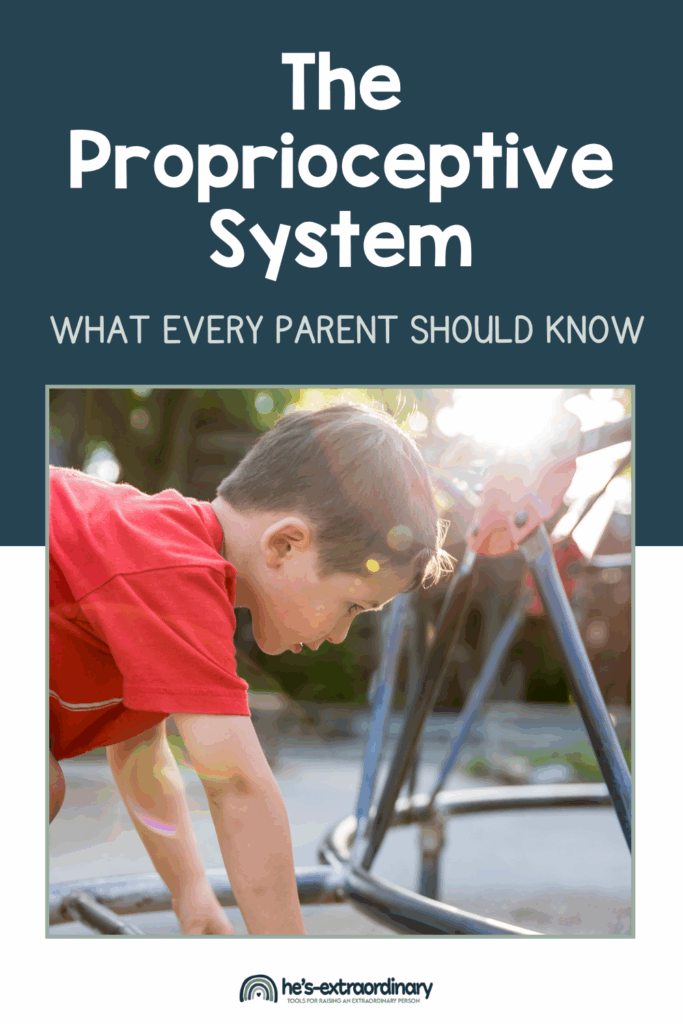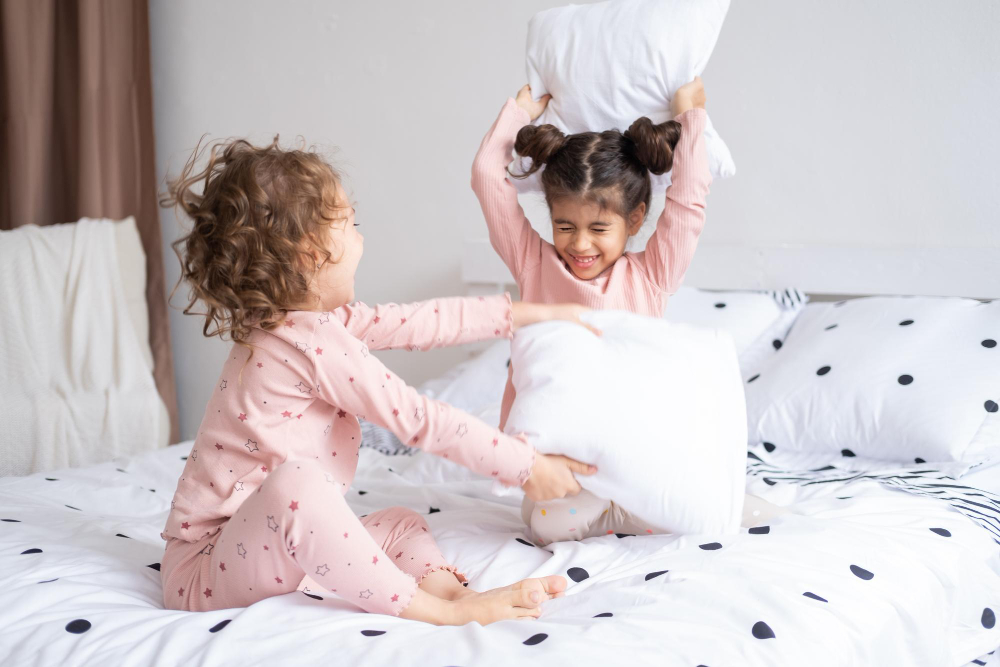How Does The Proprioceptive System Work?
What’s inside this article: An in-depth yet easy-to-understand explanation of what the proprioceptive system is and how it works. Includes signs of sensory processing challenges and strategies for managing and supporting your child’s unique sensory processing needs.
The proprioceptive system is one of your body’s most important sensory systems. It helps you understand where your body is in space without having to look. Think of it as your body’s internal GPS system.
This system uses special receptors in your muscles, joints, and tendons to sense where your body parts are and how they’re moving. This is how your body has balance and coordination.
Your sense of proprioception is how you know how much pressure to use when you pick up an egg (so it doesn’t break) versus a bowling ball. It’s the reason you can still walk in the dark or touch your nose with your eyes closed.
This sensory system is super important!
Try this quick test:
First, close your eyes and stretch your arms out straight in front of you. Then, attempt to touch your two index fingers together.
You should be able to do this on your first or second try. That’s your proprioceptive system at work.
Why This Matters for Your Child
Approximately 70% to 90% of autistic children have sensory processing differences. Additionally, up to 20% of typically developing children also have sensory differences.
But here’s what’s important to remember: Even if your child doesn’t have sensory differences, they still have sensory needs.
Everyone’s nervous system works differently, and everyone benefits from understanding how their body processes sensory information.
Sensory differences can manifest in many different ways. Some kids are more sensitive to sensory input (hypersensitivity) while other kids need more sensory input to feel regulated (hyposensitivity). If their sensory needs aren’t met, this can significantly impact daily functioning and behavior.
Understanding how your child’s proprioceptive system works can help you better support their daily experiences and recognize when their behaviors are actually their way of getting the sensory input they need.
This article takes a deeper look into the proprioceptive system, how it works, and how to help support your child’s sensory needs.
How Does The Proprioceptive System Work?
Your proprioceptive system relies on special sensors called proprioceptors. These sensors live inside your skin, muscles, joints, and tendons.
When you move, these sensors send messages to your brain through your nervous system. Your brain then processes this information to create a map of where your body is and what it’s doing.
This happens automatically and constantly …even when you’re sleeping.
So, even without sight, a person knows what their body is doing. That’s why you were able to touch your index fingers together when you closed your eyes in the exercise above, and the reason why you can walk in the dark even though you can’t see your feet.
It plays a crucial role in everyday activities, motor control, and maintaining posture.
Types of Proprioceptors
There are three types of sensory receptors that sense proprioceptive input; these are called proprioceptors.
They are:
- Muscle spindles
- Golgi tendon organs and
- Joint kinesthetic receptors.
Muscle Spindles
Located inside your muscles, these receptors are stimulated by
Muscle spindles detect how long your muscles are and how fast they’re changing length. They send this information to your brain so you know how your muscles are positioned.
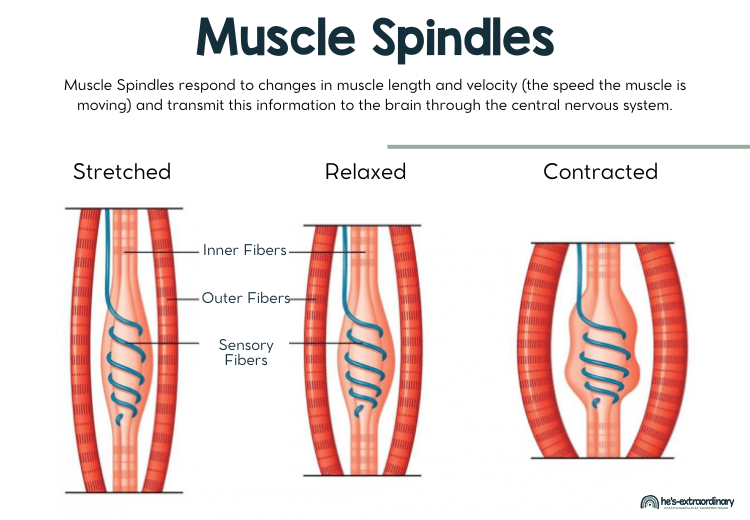
Golgi Tendon Organs
Golgi Tendon Organs (or GTO for short) are sensory receptors located in your tendons — the tissue that connects your muscles to your bones.
Golgi tendon organs sense tension and pressure. They tell your brain how much force your muscles are using.
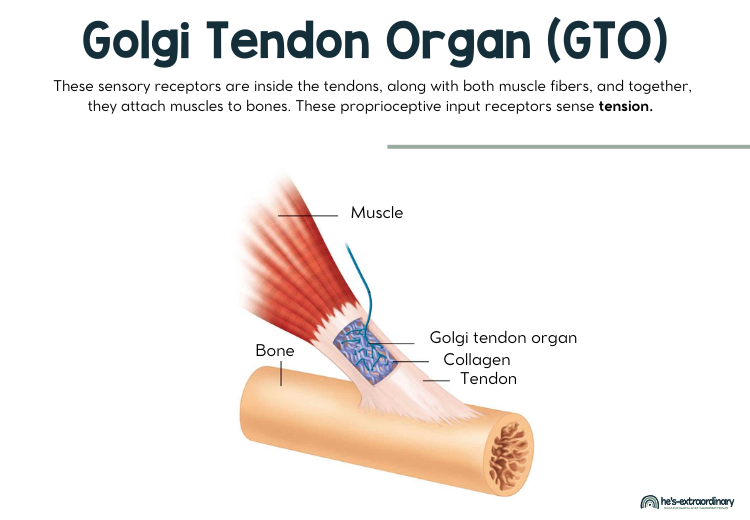
Joint Kinesthetic Receptors
Joint kinesthetic receptors are located inside your joints, where bone connects to
Joint receptors sense movement and position. When you bend your elbow or turn your head, these sensors tell your brain exactly what’s happening.
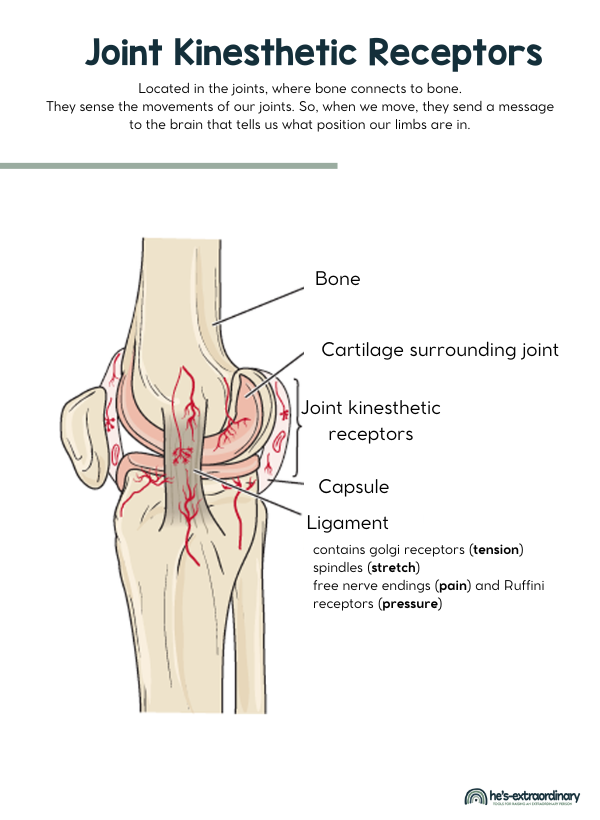
The Proprioceptive System Doesn’t Work Alone
By the way, your proprioceptive system doesn’t work alone. It works very closely with your vestibular system (your inner ear balance system) to help your body understand where it is in space and how it’s moving.
These two systems constantly share information with each other.
For example, when your child is jumping on a trampoline, their vestibular system senses the up-and-down movement while their proprioceptive system feels the muscle work and joint compression from landing.
Together, they help your child stay balanced and coordinated.
You can learn more about the vestibular system here.
How Proprioceptive Differences Show Up in Daily Life
Everyone’s proprioceptive system works a bit differently, so how differences show up in daily life can vary from one child to the next. Some people need more input to feel organized and calm, while others find that exact same sensory input overwhelming or distressing.
Children with sensory processing differences related to the proprioceptive system might show behavioral signs that seem puzzling or are mistaken for ‘bad behavior’.
For example, a child could be bursting with energy, playing too roughly, or frequently invading personal space, not because they’re a ‘bad’ kid, but because they’re trying to get more proprioceptive input.
Sometimes adults think this is purposeful misbehavior, attention-seeking, or a lack of discipline, while in reality, they might be the child’s way of coping with sensory processing challenges.
If you’re a parent, teacher, or caregiver and notice some of the behaviors listed below, consider that they may be due to sensory differences. If we are curious and determine the sensory needs at play, we can usually accommodate and redirect behavior to other activities that support those sensory needs.
Sometimes these differences will require a more tailored approach that may involve occupational therapy and sensory integration strategies. However, there are many activities you can do at home or school and you’ll find tons of ideas throughout this article.
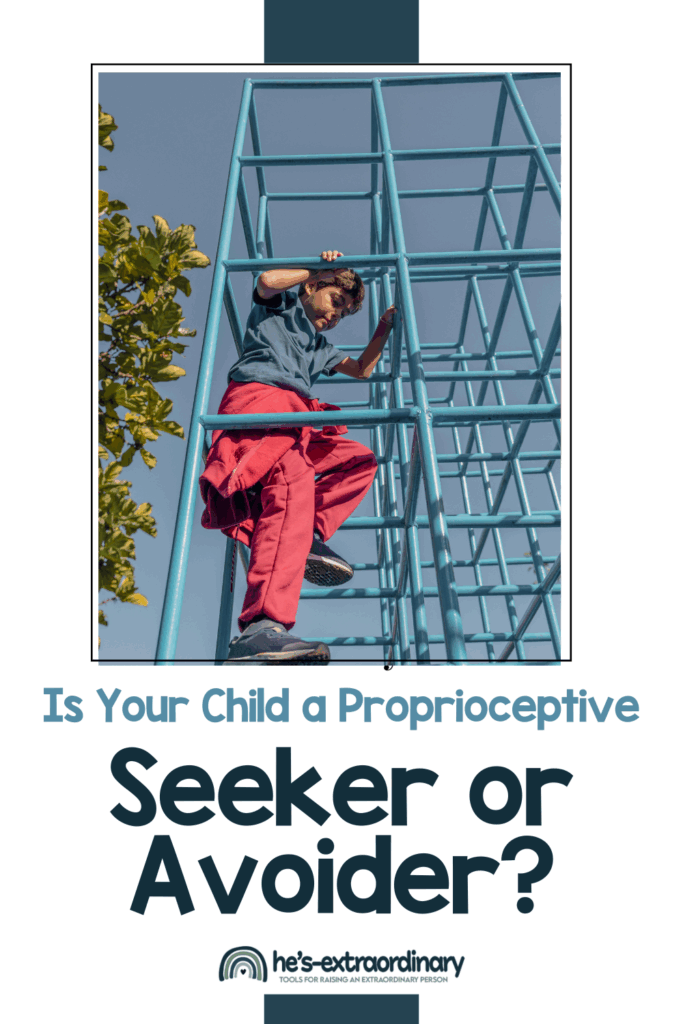
Sensory Discrimination or Perception Differences
Some children’s brains need extra time or different strategies to process proprioceptive information.
These are sensory discrimination and perception differences that occur when the brain is struggling to interpret and give meaning to sensory input.
This may look like:
- Takes a few tries to touch their finger to their nose
- Sometimes misses their mouth when self-feeding
- Looks at their feet while walking to avoid stumbling
- Has difficulty within the lines when coloring
- Has trouble catching or kicking balls
- Needs to see their body parts to point to them when asked
- Bumps into furniture, doorways, or people more often than expected
- Misjudges distances when reaching for objects
- May bite their tongue, cheek, or lips accidentally while eating
Sensory Modulation Differences
Modulation differences happen when someone’s brain either over-responds or under-responds to sensory input.
You might hear different terms used to describe these differences:
When someone needs MORE of a certain type of sensory input, they might be described as:
- Hyposensitive
- Under-responsive
- Sensory-seeking
When someone needs LESS of a certain type of sensory input, they might be described as:
- Over-responsive
- Sensory avoiding
- Sensory defensive
These are all different names for the same concepts. The first group means your child’s nervous system needs more of that sensory input to feel organized and regulated. The second group means your child’s nervous system can feel overwhelmed by that type of sensory input.
It’s also important to know that the same child can experience both types of responses. There might be times when your child needs more proprioceptive input and other times when they need less.
When Children Need LESS Proprioceptive Input
Some children’s systems work best with gentler, more predictable proprioceptive input.
They may find too much input overstimulating and distressing, causing sensory overload.
If your child needs less proprioceptive input, they may:
- Prefer quiet, calm activities over high-intensity movement-based ones
- Seem to move carefully and deliberately
- Dislike or avoid sports and active play
- Have trouble with activities that require lots of balance or coordination
- Find climbing on playground equipment challenging
- Write or draw very lightly
- Sit with unusual postures to support their body
- Prefer familiar movements over learning new physical skills
- Avoid or dislike hugs, cuddles, or unexpected touch like being bumped into
- Dislike crowded spaces where they are more likely to get jostled
- Prefer loose, non-restrictive clothing
- Dislike being moved by others, like pushed on a swing or carried
- Prefer sedentary activities over active ones
When Children Need MORE Proprioceptive Input
Sometimes kids will actively seek out more proprioceptive input because it helps them feel regulated and organized.
Children won’t always choose the best strategies to do this, because they are just kids! Their bodies will find ways to meet those sensory needs.
Seeking proprioceptive input might look like:
- Moving constantly or having trouble sitting still
- Enjoying rough play, adults might say it seems like they ‘don’t know their own strength’
- Bumping into things, walls, or people frequently
- Walking loudly or stomping as they walk
- Loving deep pressure activities like tight hugs or weighted blankets
- Enjoying intense movement activities like running, pushing, jumping, climbing, and crashing
- Chewing on clothing, pencils, and other objects (there are tons of proprioceptors in the jaw, which makes chewing very regulating for a lot of kids)
- Hiding under blankets, in small spaces, or inside of their own clothing
Learning NEW Motor Movements
Some children need extra time and practice to learn new physical skills.
You might hear the term “praxis” if you work with an occupational therapist. Praxis is also known as motor planning and refers to the cognitive process of planning, organizing, and executing unfamiliar movements or actions.
If your child has praxis differences, they might have a hard time learning new motor movements.
This may look like:
- Need more time to learn new movements like riding a bike or tying shoes
- Struggle with the coordination and different movements required for sports
- Have trouble positioning their body correctly for new activities
- Need step-by-step instructions for complex movements
- Perform better when they can practice movements slowly at first
- Have trouble with postural control when learning new skills
- Need extra practice to make new movements feel comfortable and automatic
Strategies for Supporting Your Child’s Proprioceptive Needs
The most important thing to remember is that every child’s sensory system is unique. What works for one child might not work for another.
Pay attention to what activities help your child feel calm, organized, and happy. These are clues about what their proprioceptive system needs.
You can find a lot of resources on this blog that include proprioceptive input activities, and these are among the most popular articles that I have written.
Check some of them out here:
- Proprioceptive Input Activities for Sensory Seekers
- 60 Heavy Work Activities for Kids
- Animal Themed 7 Minute HIIT
- Morning Workout for Children
- Low-Prep Outdoor Sensory Play Ideas
- Sensory Diet Activities
I’m almost going to list some activities and strategies below based on if your child needs more or needs less input. It’s important to remember that what strategies help are individualized.
Observe your child to better understand what naturally helps them feel regulated. Your child’s behavior and activity preferences are your biggest clues when it comes to collecting information on their sensory needs.
Strategies for Kids Who Prefer LESS Proprioceptive Input
Calming Proprioceptive Activities
Focus on gentle, predictable input:
- Light pressure massage
- Gentle stretching or yoga
- Slow, rhythmic movements
- Weighted blankets or other items used during quiet activities
- Soft compression clothing
Learning Support
Give your child extra time and support when learning new movements:
- Break new skills into smaller steps
- Practice in a calm, quiet environment
- Allow your child to watch others before trying
- Celebrate effort and progress, not just the end result
Environmental Modifications
Make your child’s environment more supportive:
- Provide stable seating options
- Use pencil grips or weighted writing tools
- Offer fidget tools during seated activities
- Create quiet spaces for breaks
Strategies for Kids Who Prefer MORE Proprioceptive Input
Heavy Work Activities
These activities provide deep pressure and resistance to muscles and joints:
- Pushing or pulling heavy objects like laundry baskets
- Carrying groceries or books
- Playing tug-of-war
- Doing push-ups against the wall
- Helping with yard work like raking leaves
Movement Activities
Keep your child active with activities that provide lots of proprioceptive input:
- Trampolines and bounce houses
- Playground equipment
- Swimming
- Dancing
- Yoga
- Martial arts or gymnastics
Deep Pressure Activities
These help many children feel calm and organized:
- Weighted blankets or lap pads
- Deep pressure massage
- Bear hugs
- Rolling in blankets like a burrito
- Compression clothing
What This Means for Your Family
Understanding your child’s proprioceptive system can help you see behaviors that you find challenging or disruptive from a new perspective.
That child who can’t sit still isn’t being defiant — they’re seeking the sensory input their brain needs to focus.
The child who seems “clumsy” isn’t careless — their proprioceptive system might need different strategies to process movement information.
The child who avoids active play isn’t lazy — they might find intense proprioceptive input overwhelming.
When we see their behavior from a sensory lens, we can support their sensory needs, and the ‘behavior’ often resolves or reduces naturally because their sensory needs are met.
Questions to Ask Yourself
- What activities help my child feel calm and organized?
- When does my child seem most comfortable in their body?
- What types of movement or touch does my child seek out?
- What activities seem to overwhelm my child?
- How can I modify our daily routines to better support my child’s sensory needs?
If your child has sensory differences, it’s part of who they are. The goal isn’t to change them or ‘fix’ them, or make them like everybody else. The goal is to better understand their needs and provide support so they feel comfortable in their body.
